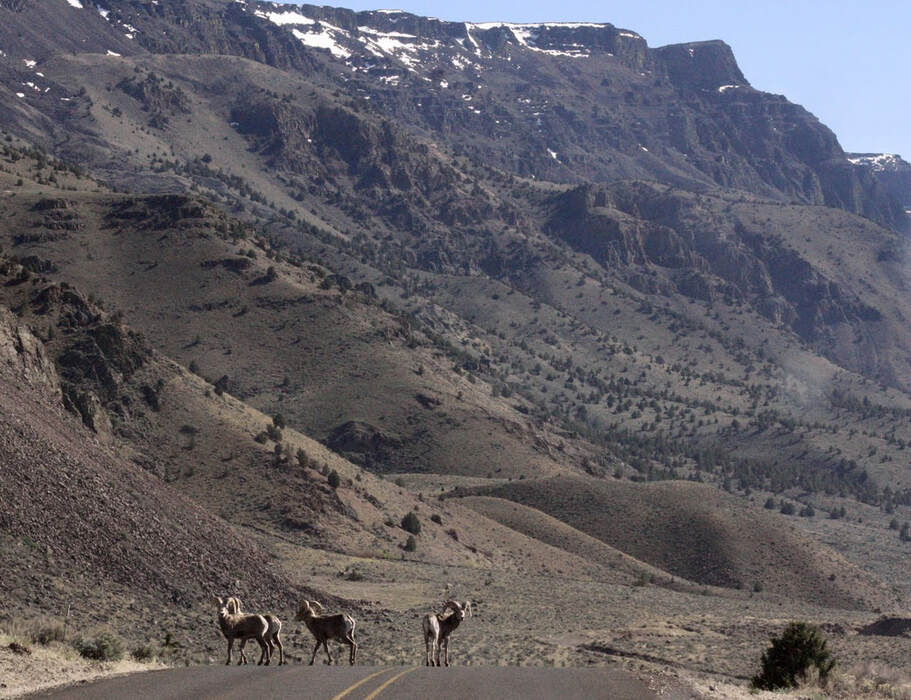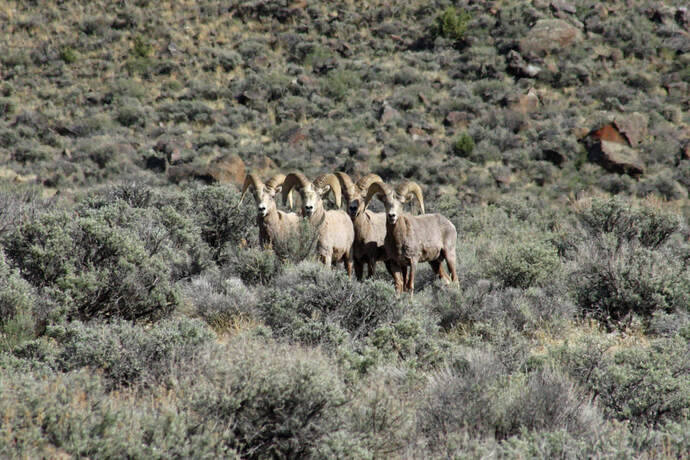Refuge Updates, January 2021
Hart Mountain Planning for Bighorn Conservation
Once abundant in Oregon and the West, the California bighorn sheep was extirpated from Oregon in 1912 due to market hunting and diseases contracted from domestic livestock. This iconic species was successfully reintroduced at Hart Mountain National Antelope Refuge in 1954, where the herd grew to over 400 by the late 1980s. Restoration was so successful that the refuge population was used as a source for multiple bighorn reintroductions elsewhere in Oregon.
Unfortunately, the refuge population declined from the mid-1990s to 2009, with the total hovering at about 150 individuals between 2009 and 2017. Numbers took another precarious dive in recent years, from 149 animals in 2017, to 100 in 2018, to just 68 sheep in 2019.
Once abundant in Oregon and the West, the California bighorn sheep was extirpated from Oregon in 1912 due to market hunting and diseases contracted from domestic livestock. This iconic species was successfully reintroduced at Hart Mountain National Antelope Refuge in 1954, where the herd grew to over 400 by the late 1980s. Restoration was so successful that the refuge population was used as a source for multiple bighorn reintroductions elsewhere in Oregon.
Unfortunately, the refuge population declined from the mid-1990s to 2009, with the total hovering at about 150 individuals between 2009 and 2017. Numbers took another precarious dive in recent years, from 149 animals in 2017, to 100 in 2018, to just 68 sheep in 2019.
The refuge is now exploring options for recovering and stabilizing its bighorn population in a new comprehensive management plan. The process will review factors ranging from habitat quality and availability of food and water to disease and predation, including options for managing mountain lions.
The refuge’s draft plan and environmental impact statement is expected to be released this spring with an opportunity for public comment. In the meantime, the refuge has posted lots of information regarding the planning process on its website.
Oregon Sage Grouse Population Holding Steady—at a Record Low
The Oregon Department of Fish and Wildlife released its annual population report for the state’s greater sage-grouse population in September . The annual census is based on lek counts conducted each spring, including on Hart Mountain. The good news—and bad news—is that the total state population essentially held even from 2019 to 2020, at what is otherwise a record low for sage grouse counted in Oregon (an estimated total of 14,201 birds).
There might also be some slivers of hope sprinkled in this year’s report. Survey efforts across eastern Oregon increased this year despite the challenges posed by the pandemic. The Beatys sage grouse Priority Area of Conservation (PAC), which includes Hart Mountain, showed a slight uptick in the number of sage grouse males counted per lek. And field study found that sage grouse nest success in the Beatys Butte region was the highest in eastern Oregon (86 percent), which might be an indication of improved habitat conditions in the area.
Thank You Refuge Staff
After a decade of service as the Project Leader for Sheldon-Hart Mountain National Wildlife Refuge Complex, John Kasbohm accepted a new position this autumn as Refuge Manager of the Chincoteague National Wildlife Refuge Complex on the eastern shore of Virginia. Caitlin Simms, former Administrative Officer, and John Owens, former Wildlife Biologist for the Sheldon-Hart Complex, have also moved on to other endeavors. We appreciate their many years of service to this incredible landscape.
We look forward to working closely with Shannon Ludwig, who is serving as Acting Project Leader for the Refuge Complex until the permanent position is filled. Danielle Fujii-Doe continues to serve as Refuge Manager at Hart Mountain. She greeted Friends members in our spring 2019 newsletter.
Looking Forward to 2021 at Hart Mountain and Your Continued Support for Friends
With the promise of “normalcy” in 2021, Friends of Hart Mountain hopes to offer many important opportunities this year to educate and promote the refuge to a public increasingly interested in Oregon’s High Desert and the wildlife that depend on it. Post-pandemic, we look forward to sponsoring volunteer trips to census wildlife populations at the refuge, including mule deer surveys and sage grouse lek counts. And we will continue to encourage member participation in our work with U.S. Fish and Wildlife Service staff on a variety of planning and management activities that help conserve this irreplaceable wildlife reserve.
Friends of Hart Mountain and the refuge we support have a bright future, but one that won’t be realized without the continued dedication and commitment of people like you! Please consider joining us in an exciting year ahead by becoming a Friends member or renewing your annual membership. Your generosity makes a difference to the wildlife and wildlands we all hold dear, and we thank you for your support.
The refuge’s draft plan and environmental impact statement is expected to be released this spring with an opportunity for public comment. In the meantime, the refuge has posted lots of information regarding the planning process on its website.
Oregon Sage Grouse Population Holding Steady—at a Record Low
The Oregon Department of Fish and Wildlife released its annual population report for the state’s greater sage-grouse population in September . The annual census is based on lek counts conducted each spring, including on Hart Mountain. The good news—and bad news—is that the total state population essentially held even from 2019 to 2020, at what is otherwise a record low for sage grouse counted in Oregon (an estimated total of 14,201 birds).
There might also be some slivers of hope sprinkled in this year’s report. Survey efforts across eastern Oregon increased this year despite the challenges posed by the pandemic. The Beatys sage grouse Priority Area of Conservation (PAC), which includes Hart Mountain, showed a slight uptick in the number of sage grouse males counted per lek. And field study found that sage grouse nest success in the Beatys Butte region was the highest in eastern Oregon (86 percent), which might be an indication of improved habitat conditions in the area.
Thank You Refuge Staff
After a decade of service as the Project Leader for Sheldon-Hart Mountain National Wildlife Refuge Complex, John Kasbohm accepted a new position this autumn as Refuge Manager of the Chincoteague National Wildlife Refuge Complex on the eastern shore of Virginia. Caitlin Simms, former Administrative Officer, and John Owens, former Wildlife Biologist for the Sheldon-Hart Complex, have also moved on to other endeavors. We appreciate their many years of service to this incredible landscape.
We look forward to working closely with Shannon Ludwig, who is serving as Acting Project Leader for the Refuge Complex until the permanent position is filled. Danielle Fujii-Doe continues to serve as Refuge Manager at Hart Mountain. She greeted Friends members in our spring 2019 newsletter.
Looking Forward to 2021 at Hart Mountain and Your Continued Support for Friends
With the promise of “normalcy” in 2021, Friends of Hart Mountain hopes to offer many important opportunities this year to educate and promote the refuge to a public increasingly interested in Oregon’s High Desert and the wildlife that depend on it. Post-pandemic, we look forward to sponsoring volunteer trips to census wildlife populations at the refuge, including mule deer surveys and sage grouse lek counts. And we will continue to encourage member participation in our work with U.S. Fish and Wildlife Service staff on a variety of planning and management activities that help conserve this irreplaceable wildlife reserve.
Friends of Hart Mountain and the refuge we support have a bright future, but one that won’t be realized without the continued dedication and commitment of people like you! Please consider joining us in an exciting year ahead by becoming a Friends member or renewing your annual membership. Your generosity makes a difference to the wildlife and wildlands we all hold dear, and we thank you for your support.


